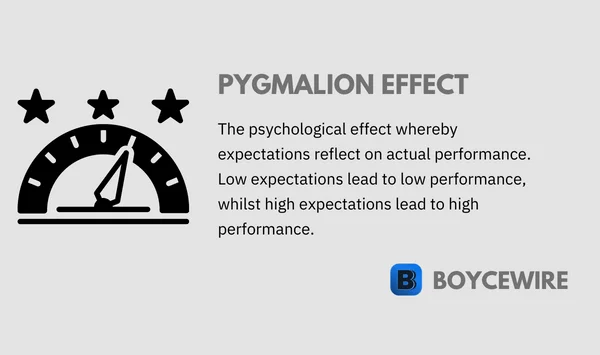Pygmalion Effect: Definition, How it works & Examples

What is the Pygmalion Effect?
The Pygmalion effect is where an individual’s performance is influenced by others’ expectations. In other words, higher expectations lead to higher performance. However, the Pygmalion effect specifically refers to how our expectations of others affect our behavior towards them. In turn, this can contribute to higher performance.
For example, school teacher Mrs. Dolety, expects her student, Toby, to do well in the exams. Those expectations influence her behavior in what is known as the Pygmalion effect. She may spend longer with Toby in explaining a topic. Or, she may provide greater feedback when presented with an incorrect answer.
By comparison, feedback to incorrect answers presented by others is expected and therefore little feedback is presented. This may be because the expectations of other students are low. They are expected to get the answer wrong. So it is seen as more important than the student with potential receives more favorable treatment.
Key Points
- Our expectations can influence how we treat people, which can influence their own expectations of themselves.
- Low expectations can mean we treat people differently to those with high expectations.
- A self-fulfilling prophecy is created. Low expectations create a negative environment that creates low performance. Whilst high expectations create a positive and encouraging environment that creates high performance.
History of the Pygmalion Effect
The Pygmalion effect was discovered by Robert Rosenthal in his 1964 study. It is otherwise known as the Rosenthal Effect, but Rosenthal named the discovery after the mythological Greek sculpture Pygmalion.
According to Greek mythology, the sculpture fell in love with the ivory statue of a woman he made, with the gods bringing her to life for him to marry. His expectations helped bring the statue to life, which fits in with the Pygmalion effect. Our expectations have the power to change reality.
Pygmalion Effect Experiment
In 1964, Robert Rosenthal hypothesized that reality can be positively or negatively influenced by our expectations of others. Rosenthal argued that such expectations could create self-fulfilling prophecies by which negative expectations lead to negative performance. In turn, the negative expectations are only re-enforced, with the individual continuing to receive unfavorable treatment.
Rosenthal conducted his experiment in a single elementary school in California. Each student took a test which was designed as a mock IQ test. After the exam, the scores were not disclosed to the teachers, but they were told the names of the individual children who were said to be ‘intellectual bloomers’.
After the school year had passed, the children were asked to take the test again. All students scored higher, but there was a notable increase in the test subjects. The ‘intellectual bloomers’ made the most progress, with First and Second Graders showing the most significant statistical gains.
The study concluded that expectations were a contributory factor in the outcome of students, particularly the youngest of children. Rosenthal believed that even subtle factors such as the mood or attitude of the teacher could affect students.
Furthermore, there was a tendency for teachers to pay closer attention to the ‘intellectual bloomers’, who were treated differently, although subtly. This occurred through factors such as greater attention and more in-depth feedback.
Rosenthal later summarised the Pygmalion effect as “the phenomenon whereby one person’s expectation for another person’s behavior comes to serve as a self-fulfilling prophecy” (American Psychologist, Nov. 2003, p. 839).
How the Pygmalion Effect works
According to Rosenthal, the Pygmalion effect works as a self-fulfilling prophecy. This can be seen to working in a circular fashion:
- People’s beliefs and expectations effect their actions towards others.
- Those actions impact on the beliefs and expectations that other people hold true about themselves.
- Those beliefs then impact on the performance of others.
- The initial belief and expectations of others are verified.
This then cycles us back to 1 where the actions start to become reinforcing.
Pygmalion Effect Examples
Here are some examples illustrating the Pygmalion effect:
- Education A teacher expects high performance from certain students based on her belief that they are more intelligent or better learners. Because of these expectations, she unconsciously provides more attention, support, and encouragement to these students, ultimately leading them to excel academically. This is a direct demonstration of the Pygmalion effect, where the teacher’s expectations influence the students’ performance.
- Workplace If a manager believes that a particular employee is highly competent and has the potential for growth, they might provide that employee with more opportunities, constructive feedback, and training. As a result, the employee may perform better and even exceed the manager’s expectations. This is the Pygmalion effect in action, where a manager’s high expectations and faith in an employee’s capabilities enhance the employee’s performance.
- Sports A coach might have a strong belief in the abilities of a specific athlete. This belief could lead the coach to spend extra time training and nurturing the athlete. In response, the athlete could push themselves harder, improving their skills and performance, fulfilling the coach’s expectations, and exemplifying the Pygmalion effect.
- Self-fulfilling Prophecy The Pygmalion effect can also apply to individuals’ expectations of themselves. If someone strongly believes that they can achieve a particular goal or task, they are likely to put in more effort, persevere despite challenges, and eventually, succeed, validating their original belief.



These examples highlight how the Pygmalion effect can manifest in various aspects of life, underscoring the power of expectations in shaping outcomes.
How to use the Pygmalion Effect
The Pygmalion Effect extends beyond the traditional classroom setting. It also stretches towards the business world and other leadership settings. It is for this very reason that the Pygmalion effect is a crucial part of the business setting and getting the best out of employees and students alike.
1. Be aware of expectations
The Pygmalion Effect is where our expectations of others affect our behaviour towards them. If we first acknowledge its existence, we can adapt our thoughts and actions.
It is important to realize when we have different expectations. If we do, just being aware can help us proactively avoid negative actions. So instead of spotting weaknesses in people, we can look at the positives and their potential.
We can become aware of when our expectations are resulting in negative actions. For instance, we may shout at someone who we may have low expectations. In such examples, it is important to acknowledge such and try and prevent reoccurrence.
2. Identify Positive Traits
Sometimes we may have low expectations for others and there is no way around it. Whether it’s a colleague, a delegate, a friend, or someone else. They may seem completely incompetent. It is for that reason that it can be difficult to expect much from them, which can, in turn, influence our actions.
If we can identify and communicate some positive traits, we may be able to lift expectations. In turn, these can drive others on and potentially reach their potential which we couldn’t previously envisage.
From famous soccer players to baseball, to acting, there have been thousands who have exceeded expectations. It is therefore important for us to identify those traits which we may overlook.
3. Create Challenges
When we achieve a goal, we feel a sense of accomplishment. Employees can grow with a sense of empowerment to reach ambitious goals. If they are challenged, they not only can exceed your own expectations but also theirs.
If we set tasks that we believe may be above our expectations of them and encourage them that they can do it, they will put everything into it. When high expectations are expected, we often do all we can to fulfil them.
4. Positive Language
Whether be believe someone is capable or not, belittling them won’t help. Saying things like ‘I’m not sure you can do this’ or ‘Can you try’, can be negatively taken. Such phrases emphasize a lack of trust and low expectations.
By complimenting others and identifying the strengths they have shown, we can create positive expectations for them. In turn, this can influence our own actions. As we focus on their positive attributes, it also creates a heightened level of expectation. This can then turn into a positive self-fulfilling prophecy.
5. Provide Feedback
Whether it’s a student, employee, or someone else, it is important to provide actionable feedback. One of the flaws that occur with the Pygmalion effect is the lack of consideration and effort given to those with low expectations. Under the effect, we may not both with providing any feedback because ‘there is no point’, or ‘they won’t be able to do anything’.
Rather than dwell on the what-ifs or whether the feedback would be of use, it is important to at least give it a shot. Instead of letting our expectations become a reality, give the person a chance to improve, develop, and prove you wrong.
Some examples may include, employee reviews or training, or one-on-one feedback.
FAQs
There have been many other studies that followed on from Rosenthal’s in 1964, with the vast majority concluding its existence. The basis of such is psychological and self-fulfilling. Once we have certain expectations of someone, we tend to reinforce these with our actions, whether consciously or sub-consciously.
In teach, the Pygmalion effect occurs when teachers treat students different because of their expectations. For example, students with low expectations may receive less attention or less detailed feedback. So when the student answers a question incorrectly, the teacher may not respond with a detailed explanation of the correct answer. However, a student with high expectations may receive a more detailed response. The reason for such is that students with low expectations are meeting them with incorrect answers. Yet students with high expectations that provide wrong answers need that help to get it right, whilst the those with low expectations may be seen as unable to understand.
The Pygmalion effect is important because it can influence our actions and create a self-fulfilling cycle. In order to get the most out of others, whether employees, colleagues, or otherwise, it is important to understand how our beliefs can affect our actions. By understanding such, we can look to develop those who we may have low expectations for rather than preventing them from developing.
About Paul
Paul Boyce is an economics editor with over 10 years experience in the industry. Currently working as a consultant within the financial services sector, Paul is the CEO and chief editor of BoyceWire. He has written publications for FEE, the Mises Institute, and many others.

Further Reading
 Neoliberalism: Definition, Pros, Cons & Characteristics - Neoliberalism refers to the resurgence of free market ideas that characterized classical liberalism in the 19th century.
Neoliberalism: Definition, Pros, Cons & Characteristics - Neoliberalism refers to the resurgence of free market ideas that characterized classical liberalism in the 19th century.  Corporate Social Responsibility (CSR): Definition & Examples - Corporate Social Responsibility (CSR) is a type of corporate strategy that looks at how the business can better society as…
Corporate Social Responsibility (CSR): Definition & Examples - Corporate Social Responsibility (CSR) is a type of corporate strategy that looks at how the business can better society as…  Inferior Goods - Inferior goods are products or services that experience a decrease in demand as consumer income rises, typically due to the…
Inferior Goods - Inferior goods are products or services that experience a decrease in demand as consumer income rises, typically due to the… 